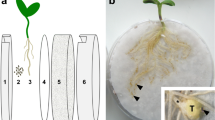Abstract
The necessity for conducting elements within haustoria of phanerogamic parasites is obvious, especially since holoparasitic angiosperms lack roots and assimilatory organs. Water as well as organic substances must be taken up, therefore, by specialized haustoria (Kuijt 1969; Kollmann and Dörr 1987). The faster the parasite grows, the more efficient must be the cells developed specifically for nutrient transport.
Access this chapter
Tax calculation will be finalised at checkout
Purchases are for personal use only
Preview
Unable to display preview. Download preview PDF.
Similar content being viewed by others
References
Ba AT (1983) Biologie du parasitisme chez deux Scrophulariacées tropicales. Thesis, Univ Dakar.
Behnke H-D (1965) Über das Phloem der Dioscoreaceen unter besonderer Berücksichtigung ihrer Phloembecken, II. Mitteilung: Elektronenoptische Untersuchungen zur Feinstruktur des Phloembeckens. Z Pflanzenphysiol 53: 214–244.
Behnke H-D (1981) Sieve-element characters. Nord J Bot 1: 381–400.
Bennett CW (1944) Studies of dodder transmission of plant viruses. Phytopathology 34:905–932.
Benson M (1910) Root parasitism in Exocarpus (with comparative notes on the haustoria of Thesium). Ann Bot (London) 24: 667–677.
Calvin CL (1967) Anatomy of the endophytic system of the mistletoe Phoradendron flavescens. Bot Gaz 128: 117–137.
Damaschke U (1982) Strukturelle und physiologische Untersuchungen am Stoffaufnahme-System des Hemiparasiten Cassytha. Thesis, Christian-Albrechts-Univ Kiel.
Dobbins DR, Kuijt J (1973) Studies on the haustoria of Castilleja. (Scrophulariaceae). II. The endophyte. Can J Bot 51: 923–931.
Dörr I (1968) Zur Lokalisation von Zellkontakten zwischen Cuscuta odorata und verschiedenen höheren Wirtspflanzen. Protoplasma 65: 435–448.
Dörr I (1969) Feinstruktur intrazellulär wachsender Cuscuta-Hyphen. Protoplasma 67: 123–137.
Dörr I (1972) Der Anschluß der Cuscuta-Hyphen an die Siebröhren ihrer Wirtspflanzen. Protoplasma 75: 167–184.
Dörr I (1987) The haustorium of Cuscuta — new structural results. In: Weber HC, Forstreuter W (eds) Proc 4th Int Symp Parasitic flowering plants, Marburg, FRG, pp 163–170.
Dörr I, Kollmann R (1975) Strukturelle Grundlagen des Parasitismus bei Orobanche. IL Die Differenzierung der Assimilat-Leitungsbahnen im Haustorialgewebe. Protoplasma 83:185–199.
Dörr I, Visser JH, Kollmann R (1979) On the parasitism of Alectra vogelii Benth. (Scrophulariaceae) III. The occurrence of phloem between host and parasite. Z Pflanzenphysiol 94:427–439.
Esau K (1969) The phloem. In: Zimmermann W, Ozenda P, Wulff HD (eds) Encyclopedia of plant anatomy, vol 5, pt. 2. Borntraeger, Berlin Stuttgart, 505 pp.
Fineran BA (1985) Graniferous tracheary elements in haustoria of root parasitic angiosperms. Bot Rev 51: 389–441.
Fineran BA, Juniper BE, Bullock S (1978) Graniferous tracheary elements in the haustorium of the Santalaceae. Planta 141: 29–32.
Gouws J, Visser JH, Grobbelaar N (1980) Some aspects of the bidirectional translocation of 14C-labelled metabolites between Alectra vogelii Benth. and Voandzeia subterranea (L.) Thou. Z Pflanzenphysiol 99: 225–233.
Israel S, Dörr I, Kollmann R (1980) Das Phloem der Haustorien von Cuscuta. Protoplasma 103:309–321.
Kollmann R, Dörr I (1969) Strukturelle Grundlagen des zwischenzelligen Stoffaustausches. Ber Dtsch Bot Ges 82: 415–425.
Kollmann R, Dörr I (1987) Parasitische Blütenpflanzen. Naturwissenschaften 74:12–21.
Kollmann R, Dörr I, Schulz A, Behnke H-D (1983) Funktionelle Differenzierung der Assimilatleitbahnen. Ber Dtsch Bot Ges 96: 117–132.
Kuijt J (1969) The biology of parasitic flowering plants. Univ Cal Press, Berkeley Los Angeles.
Kuijt J, Dobbins DR (1971) Phloem in the haustorium of Castilleja (Scrophulariaceae). Can J Bot 49:1735–1736.
Kuijt J, Toth R (1976) Ultrastructure of angiosperm haustoria — a review. Ann Bot (London) 40:1121–1130.
Kuijt J, Bray D, Olson AR (1985) Anatomy and ultrastructure of the endophytic system of Pilostyles thurberi (Rafflesiaceae). Can J Bot 63:1231–1240.
Lee KB (1986) Studies on the haustorial development of Cuscuta australis R. Brown. Thesis, Sung Kyun Kwan Univ, Seoul.
Mauseth JD, Montenegro G, Walckowiak AM (1984) Studies of the holoparasite Tristerix aphyllus (Loranthaceae) infecting Trichocereus chilensis (Cactaceae). Can J Bot 62: 847–857.
Mauseth JD, Montenegro G, Walckowiak AM (1985) Host infection and flower formation by the parasite Tristerix aphyllus (Loranthaceae). Can J Bot 63: 567–581.
Menzies BP (1954) Seedling development and haustorial system of Loranthus micranthus Hook. Phytomorphology 4: 397–409.
Nagar R, Singh M, Sanwal GG (1984) Cell wall degrading enzymes in Cuscuta reflexa and its hosts. J Exp Bot 35:1104–1112.
Peirce GJ (1893) On the structure of the haustoria of some phanerorgamic parasites. Ann Bot (London) 7: 291–327.
Sallé G (1976) Le phloème des cordons corticaux du Viscum album L. (Loranthacées). Protoplasma 87: 17–25.
Sallé G (1979) Relations cyto-physiologiques entre le Viscum album L. et le pommier. Bull Soc Bot Fr 126, Actual Bot 79–95.
Schulz A (1987) Sieve-element differentiation and fluoresceine translocation in wound-phloem of pea roots after complete severance of the stele. Planta 170: 289–299.
Schumacher W (1934) Die Absorptionsorgane von Cuscuta odorata und der Stoffübertritt aus den Siebröhren der Wirtspflanzen. Jahrb Wiss Bot 80: 74–91.
Sjolund RD, Shih CY (1983) Freeze-fracture analysis of phloem structure in plant tissue culture. I. The sieve element reticulum. J Ultrastruct Res 82:111–121.
Thoday MG (1911) On the histological relation between Cuscuta and its host. Ann Bot (London) 25: 655–682.
Visser JH, Dörr I (1987) The haustorium. In: Musselman LJ (ed) Parasitic weeds in agriculture, vol 1. Striga. CRC, Boca Raton, Fla, pp 89–106.
von Mohl H (1827) Über den Bau und das Winden und Ranken der Schlingpflanzen. Preisschr Med Fak Univ Tübingen.
Ziegler H (1955) Lathraea, ein Blutungssaftschmarotzer. Ber Dtsch Bot Ges 68: 311–318.
Editor information
Editors and Affiliations
Additional information
Dedicated to my mother
Rights and permissions
Copyright information
© 1990 Springer-Verlag Berlin Heidelberg
About this chapter
Cite this chapter
Dörr, I. (1990). Sieve Elements in Haustoria of Parasitic Angiosperms. In: Behnke, HD., Sjolund, R.D. (eds) Sieve Elements. Springer, Berlin, Heidelberg. https://doi.org/10.1007/978-3-642-74445-7_12
Download citation
DOI: https://doi.org/10.1007/978-3-642-74445-7_12
Publisher Name: Springer, Berlin, Heidelberg
Print ISBN: 978-3-642-74447-1
Online ISBN: 978-3-642-74445-7
eBook Packages: Springer Book Archive



